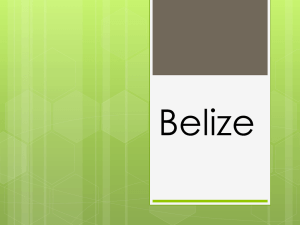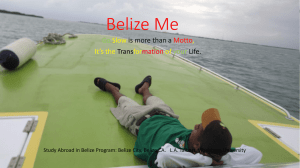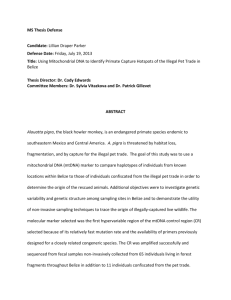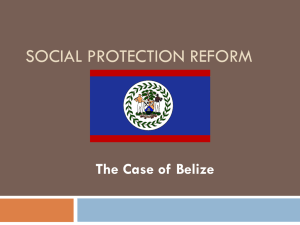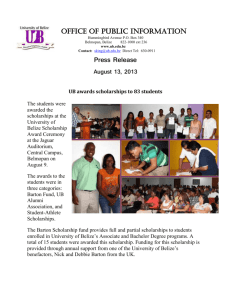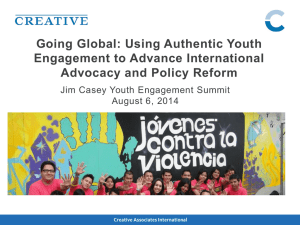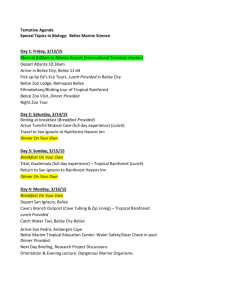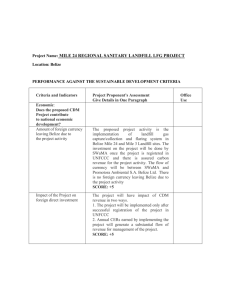Northern Belize Fishing Communities Characterization Prepared by
advertisement
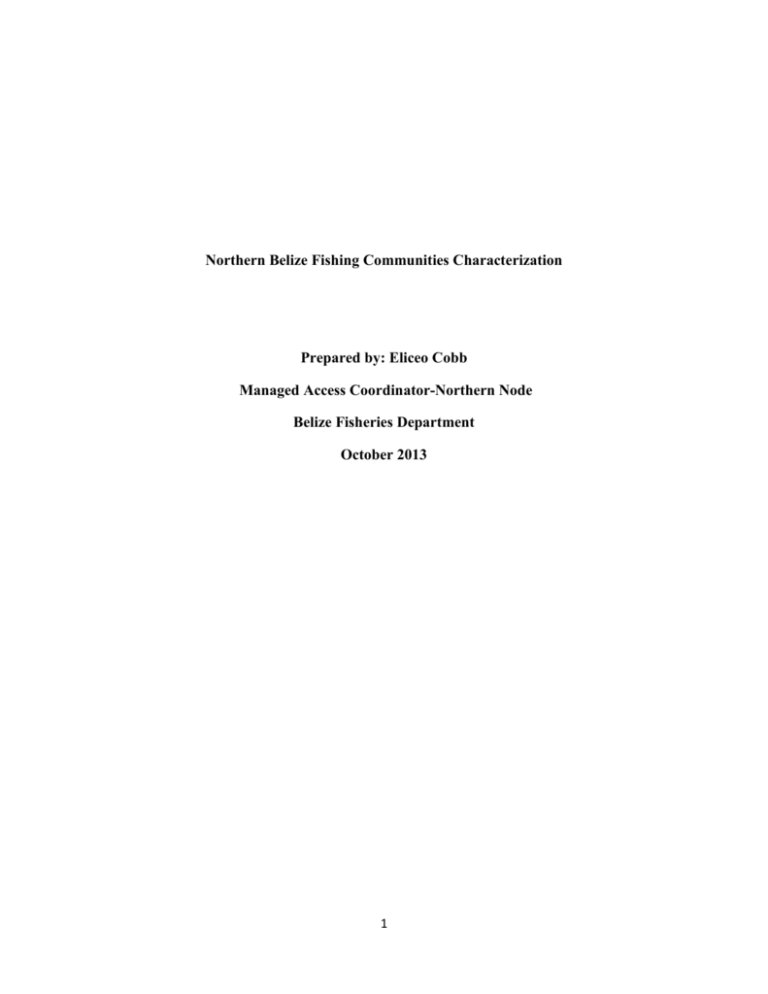
Northern Belize Fishing Communities Characterization Prepared by: Eliceo Cobb Managed Access Coordinator-Northern Node Belize Fisheries Department October 2013 1 Table of Content Acknowledgement ……………………………………………………………….. 3 Introduction ………………………………………………………………... 4 Sarteneja ………………………………………………………………... 5 Copper Bank ………………………………………………………………… 9 Chunox …………………………………………………………………. 12 Corozal …………………………………………………………………. 15 Orange Walk …………………………………………………………………. 19 The Life of a Fisherman ...………………………………………………………… 22 References …………………………………………………………………. 25 Annexes …………………………………………………………………. 26 2 Acknowledgements I would like to take this opportunity to give special thanks to the Managed Access mentors team from the Belize Fisheries Department, Environmental Defense Fund, Wildlife Conservation Society, and Rare. Their guidance and recommendations in the approach techniques used were very fundamental in building a baseline trustworthy relationship with fishers in the Northern Communities of Belize throughout this two months immersion phase. To all the fishermen in these specific villages in Northern Belize that were contacted and gave us a warmth welcome to their village and to some extent to their homes, a special thanks to them also. To person and entities in the villages of Sarteneja, Chunox, and Copper Bank, that are key elements focused in the interest of fishers in the fishing industry; National and Northern Fishermen Cooperative Committee representatives and the Fishermen Association in Sarteneja and Chunox, a great appreciation is extended to them for their assistance in reaching to fishers and in providing me with an insight of the fishers in these villages. Special thanks also goes to the Sarteneja Alliance for Conservation and Development for providing me with literature reviews of the Sarteneja and the Statistical Institute of Belize office in Corozal and Orange Walk for providing me with necessary statistics of these communities. 3 1.0 Introduction The country of Belize which was formerly known as British Honduras until 1973, lies on the eastern or Caribbean coast of Central America. The country is bordered in the north and part of the west by Mexico, and on the south and remainder of the west by Guatemala. Belize is located on 15° 52’ 29’’ and 18° 29’ 55’’ North Latitude 87° 28’’ and 89° 13’ 67’’ West Longitude. The country is sheltered by the Belize Barrier Reef, with shallow inner water. Belize’s main income generating industries are sugar, citrus, fisheries, tourism and banana. Belize has an estimated population of 312,698 persons, with English being the official language of the country (Statistical Institute of Belize, 2010 Census). However, English Creole is widely spoken and remains a distinctive part of everyday conversations for most Belizeans. Spanish is also common, especially in northern Belize and is taught in primary and secondary schools in order to further develop bi-lingualism. The country of Belize is referred to as a melting pot of many races, and the multi-racial make-up is increasing throughout the years. The Statistical Institute of Belize (2010 Census) shows that the main ethnic groups in the country are the: Mestizo (50%), Creole (25%), Ketchi, Yucatec and Mopan Mayas (10%), Garifuna (4.6%) and East Indian. Other ethnic group includes: German and Dutch Mennonites, Chinese, Arabs and Africans accounts for a small percentage of the population. The ethnic groups, however, are heavily intermixed. This document was developed with the aim of characterizing the fishing communities, both traditional and non-traditional, in the Northern Belize. The document contains vital data of the following communities: Sarteneja, Copper Bank, Chunox, Consejo, Corozal, and Orange Walk. The data presented are from literature reviews and ground source persons from within the above mentioned communities. These site summaries will be a crucial component necessary for the expansion of the Managed Access Program in Belize’s Marine Reserves and for the design and implementation of the PRIDE Campaign-on the Behavior Change for people of these fishing communities. The fishing industry has been a vital part of the Belizean economy accounting for 7.2% of the GDP in (SIB, 2001 Census). These northern communities have grown in fishing from a subsistence type activity to a commercial activity with their products being exported to the U.S., Europe and the Caribbean. The export market opened in the 1920s, with lobster and conch being the top exported products. These products have remained important parts of catches for fishermen in Belize. Fishermen from these communities are important stakeholders of key fishing grounds along the Belize Barrier Reef which include, Glovers', Turneffe, Lighthouse Reef Atolls, and some areas in southern Belize. 4 2.0 Sarteneja 2.1 General Information Geographic Location Sarteneja is located in Corozal District, on the north east point of the mainland Belize, approximately 100km north of Belize and 26km south east of the district capital of Corozal. The village could be accessed by land from Orange Walk through the villages of Progresso and San Estevan. It is also possible to reach to the village by road from Corozal, crossing the New River via the Pueblo Nuevo ferry, and a second ferry situated on the mouth of Laguna Seca. Sarteneja can also be access by boat through Corozal Bay. Picture 1: Sarteneja Village Sea Side: Common Hanging Spot for Villagers. Demographics Sarteneja is the largest fishing community in Belize with over 350 fishermen (Fisheries Department). The village has an estimated population of 1,833, with 925 males to 908 females, residing in 431 households. There are around 538 person (students) being enrolled within an educational institution, of which only 30 have attained a tertiary degree (Associates & University Degree) (Statistical Institute of Belize, 2010 Census). Local History and Culture The name ‘Sarteneja’ was derived from the Yucatec Maya “Tzaten-a-Ha”, which is thought to translate as “water in the rock”. This community was established in the mid 1800’s, on the site of an old Maya seaport. The village is composed mainly of Mestizo/Hispanic people and creole to a small extent, with the main language spoken being Spanish (SIB, 2010 Census). 5 The presence of different religious denominations in the village include: Pentecostal, Nazareen, Adventists, Catholic, Jehova Witness, Baptist, and Assembies of God (J. Verde, Personal Communication, August 2013). In the past the residents of the community did agriculture, mainly from milpa farming, to earn some income for their families. They grew tropical fruits along with some crops like; peppers, beans, tomatoes, sweet potatoes. In more recent history, the people from the village started to focus on the fishing industry, based on two main marine species the queen conch and the Caribbean spiny lobster, along with the boat building (Sarteneja Tourism Development Plan). The people of Sarteneja are considered stakeholders of the Belize Barrier Reef System, with perhaps the most dependence on the harvesting of marine products. The community is home to one third of the commercial fishermen in the country (Program for Belize, 2003), with over 80% of households within the community being dependent on the marine resources (SACD community consultations, 2005). These fishers are members of the two largest cooperatives in Belize: Northern and National Fishermen Cooperatives. Cultural Attractions Sarteneja is considered a small tourism destination with great potential for expansion. Some cultural attraction include: 1. Easter Regatta: Is an annual 2 days event that involves the entire community and neighbour villages. The event has many forms of entertainment that includes; boat racing, competitions, dances, music, and a performance of the traditional hogshead dance. 2. Boat Building: The boat building grew side by side with the fishing tradition in Sarteneja. The first boat builder was Peter Young until the 1957. In the 60’s and 70’s there was a peak in boat building, with builders averaging to two boats per annum. These boats are built mainly for fishing with the owners being from Sarteneja, Caye Caulker, Copper Bank, and Chunox. Presently, the traditional wooden boats are still built and for the same fishing purposes. 3. Sailing: Sailing along the Corozal Bay in fishing boats with skilled local fishermen. With manatees and dolphins making the trip amazing. 4. Home Stay: Living with the local families and experiencing the traditional life in Sarteneja. Meeting the community-based conservation organizations that aims at promoting alternative livelihoods in conjunction with environmental sustainability, and participate and support their activities. 5. Local Artist: Sarteneja artist take inspiration from the Mayan history, local sailing tradition and picturesque scenery and insert their imagination into meaningful paintings. 6 6. Museum: Under the management of the Guardians of History, Culture, and Nature, the museum displays Mayan artifacts and tools found in Sarteneja area along with preserved specimens and provides insight in to the history of the village. Along with the Cultural attractions, some recreational attractions include: bird watching, cycling, camping, hiking, fly-fishing, swimming and sunbathing, kayaking, snorkelling and diving. Natural Attractions 1. 2. 3. 4. Shipstern Nature Reserve (SNR) Corozal Bay Wildlfie Sancuatry (CBWS) Bacalar Chico Marine Reserve & National Park (BCMN/NP) Fireburn Reserve (FB) Services provided 1. Water system a. Potable water system (up grading at the moment) b. Aqua Pura purified water 2. Electricity-Belize Electricity Limited 3. Phone Service a. Smart b. Digicell 4. Cable Service a. Sarteneja Cable System 5. Transportationa. Bus (Sarteneja bus line), b. Personal vehicle, c. Boat (personal skiffs and sailing boats) d. Thunderbolt water taxi 6. Health Centers a. Assigned nurses and doctors, not permanent. 7. Schools a. Sarteneja RC School b. Sarteneja Nazarene School c. Sarteneja Baptist High School d. St. Viator High School 8. Internet a. BTL b. Smart 9. Groceries stores 10. Community Center 7 11. Restaurants a. Liz Fast Food b. Pablito’s Restaurant 12. Hotels a. Candeli’s b. Fernando’s c. Oasis d. Home Stay Program 2.2 Stakeholders and Key Influences Local Government Structures Village Council: Chairperson-Lucio Guerrero, Councilors-Diogenes Perez, Darnel Cruz, Jessie Cruz, Jemayel Verde, Roberto Blanco & Gaspar Cantun. Non-Government Organizations 1. Sarteneja Fishermen Association (SFA) - is a community-based membership organization, with an Executive Board of Directors of seven, elected from a membership of 151 Sarteneja licensed fishermen. The SFA was registered on 19th September 2007 and seeks to provide alternative / supplemental livelihood options for fishermen of Sarteneja, reducing the dependence of the community on the declining lobster and conch resources of the Belize Barrier Reef. 2. Sarteneja Alliance for Conservation and Development (SACD) - has existed since 2007. SACD is dedicated to improving the quality of life of stakeholder communities of Corozal Bay Wildlife Sanctuary through conservation, outreach, protected area management activities, and the promotion of the sustainable use of the natural resources. 3. Sarteneja Tour Guide Association (STGA) – promotes Sarteneja as a tourism destination, providing opportunities for alternatives livelihoods for local fishermen in the tourism industry. Represents and supports Sarteneja’s tour guides and liaises with the Belize Tourism Board and the Tourism Industry Association. 4. Sarteneja Tourism Committee (STC) - promotes Sarteneja as a key destination for tourists arriving to Belize to emphasize on conservation; provide employment opportunities for the local community, improve infrastructure and highlights Sarteneja’s natural beauty with its virgin forest and wildlife. 5. Guardians of History, Nature and Culture (GHNC) – promotes history and culture of Sarteneja. 6. Sarteneja Tilapia Growers Association 7. Sarteneja Womans Group 8 Partner Organizations 1. Blue Ventures – is an international marine-based organization founded in 2003 that works with local communities to conserve threatened marine ecosystems and work on coastal livelihoods. 2. Wildtracks – works towards the sustainable use of the natural resources of Belize, through conservation, research, education, and sustainable development. 3. Belize Audubon Society (BAS) – is a non-profit, non-governmental organization based in Belize, dedicated to the conservation and protection of Belize natural resources, through advocacy, education, research, and sustainable use of the natural resources. 4. Northern Fishermen Cooperative 5. National Fishermen Cooperative 3.0 Copper Bank 3.1 General Information Geographic Location Copper Bank is located in the Corozal District. The village is situated on the west bank of Laguna Seca, a shallow lagoon that empties into Chetumal Bay just north-east of the village. It could be accessed through road from Orange Walk, via the villages of San Estevan and Progresso. It is also possible by road from Corozal, crossing the New River via the Pueblo Nuevo ferry, and from the community of Chunox, via a ferry across the mouth of Laguna Seca. 9 Picture 3. Copper Bank Village Lagoon Side: Common Hanging Spot of Villagers Demographics Copper Bank (San Fernando) is the smallest of the three fishing village in northern Belize with over 80 fishermen (Fisheries Department). These fishermen are members of the National and Northern Fishermen Cooperatives in Belize. The community has a population of 470 persons, with 236 males to 234 females, residing in 103 houses. There are 144 person (students) being enrolled within an educational institution, of which only 8 have attained a tertiary degree (Statistical Institute of Belize, 2010 Census). Local History and Culture The village was named in 1877 after the English arrived and found some old copper coins from San Fernando (Explore Belize.com). The place was first inhabited by the Maya as many other places in Belize. The Mestizos are the main inhabitants of the village, with Spanish being the mother language spoken in the village. The Catholics, Adventist, and Pentecostals are the three active religious denominations present in the village (J. Tzul, Personal Communication, August 2013). In the past the residents of the community did mainly agriculture, cane farming, and to a small extent fishing, to earn some income for their families. They grew some crops and sold them to Corozal or Orange Walk Districts. In most recent history the people in the village started doing masonry, carpentry, and venturing more into the fishing industry. The fishers 10 based themselves on two main marine species, queen conchs and the Caribbean spiny lobster, as their neighbor village of Sarteneja. The people of Copper Bank are considered stakeholders of the Belize Barrier Reef System, especially of Lighthouse and Turneffe Reef Atolls. Presently, most of the households in the community are dependent on fishing as a main source of income for their families, with the remaining focusing on cane farming, masonry, and agriculture (such as plantain farming). There is also a small percentage of the community laboring at the Corozal Commercial Free Zone to earn some income for a living. Cultural Attractions 1. San Juan Fiesta- this catholic religious tradition has been held for many years ago. It is celebrated every year on the 24th of June, with a mass, live music, and the performance of the tradition hogshead dance. Natural Attractions 1. Cerros Maya Ruins- is located at the mouth of the New River as it empties into Corozal Bay in the northern Corozal District. Cerros was inhabited from about 400 BC (Preclassic Era) to 400 AD (Classic Era) when it was abandoned. 2. Corozal Bay Wildlife Sanctuary Along with the cultural & natural attractions, some recreational attractions include: bird watching, cycling, canoe rides along the laguna seca to look for manatees and crocodiles, and boat rides along the Corozal Bay Wildlife Sanctuary. Services Provided 1. Water system- Rain water 2. Electricity- Belize Electricity Limited 3. Phone Servicea. Community phone (BTL) b. Digicell c. Smart 4. Cable Service- Dish service 5. Transportationa. COBB bus line: To Corozal Town b. Personal vehicles 6. Health Centers-Clinic 7. Schools a. Copper Bank R.C School 8. Interneta. Smart 11 b. Satellite 9. Groceries stores-Yes 10. Restaurants a. Copper Bank Inn b. Chinese 11. Hotels a. Copper Bank Inn 3.2 Stakeholders and Key Influences Local Government Stucutures Village Council: Chairman-Ruben Cobb, Councilors-Edney Cobb, Edwin Tzul, Luis Santoya, Luis Tzul, Elder Olivera, and Miguel Cobb. Partner Organizations 1. 2. 3. 4. Belize Audubon Society (BAS) Belize Cane Farmers Association Northern Fishermen Cooperative National Fishermen Cooperative 4.0 Chunox 4.1 General Information Geographic Location Chunox in the Corozal District; is situated on the east bank of Laguna Seca toward the south end of the lagoon. The village could be accessed through road from Orange Walk, via the villages of San Estevan and Little Belize. It is also possible to reach to the village by road from Corozal crossing two ferries, the Pueblo Nuevo ferry in the New River, and the Copper Bank ferry across the mouth of Laguna Seca. 12 Picture 4: Chunox Village Pier Demographics Chunox is the second largest of the three fishing village in northern Belize, with over 130 fishermen (Fisheries Department). These fishermen are members of both the National and Northern Fishermen Cooperatives in Belize. The community has a population of 1,378 persons, with 707 males to 676 females, residing in 234 houses. There are 427 person (students) being enrolled within an educational institution, of which only 21 have managed to attain a tertiary degree (Associates & University Degree) (Statistical Institute of Belize, 2010 Census). Local History and Culture The village is composed of mainly the Mestizos, with Spanish being the mother language spoken in the village. The village has five active religious denominations; the Catholic, Pentecostal, Adventist, Assembly of God, and the Shadai; with each denomination following their own beliefs (A. Santoya, Personal Communication, September 2013). In the past the residents of the community did mainly agriculture and cane farming as their main source of income. The villagers grow crops such as; plantain, sweet paper, tomato, pine apple, corn, beans, and habanero and sell them to Corozal, Orange Walk, and mainly to Belize City and San Pedro. In most recent history the people in the village started venturing into the fishing industry, due to the rapid increase in population and high increase in drop out students form primary school. The people of Chunox are now also considered stakeholders of the Belize Barrier Reef System, especially of Lighthouse Reef Atoll and Turneffe Reef Atoll. Presently, more than half of the households in the community are dependent on fishing as a main source of income for their families, with the remaining focusing on agriculture and to a small extent masonry 13 and carpentry. There is a small percentage of person of the communities earning some income from the nearby community of Little Belize, in running charter trips and any type of labor force, and from the present construction of Orchid Bay Community, a tourism-based community in between Copper Bank and Chunox right on the edge of the Corozal Bay. Natural Attractions 1. Cerros Maya Ruins 2. Corozal Bay Wildlife Sanctuary 3. Wareigh Bight Nature Reserve Along with the cultural & natural attractions, some recreational attractions include: bird watching, canoe rides along the laguna seca and progresso lagoon to look for manatees and crocodiles. Services provided 1. Water system-Potable water system 2. Electricity-Belize Electricity Limited 3. Phone Service a. Digicell b. Smart 4. Cable Service a. Dish Services 5. Transportation a. Sarteneja bus line-To Orange Walk Town & Belize City b. Cobb bus service- To Corozal Town c. Personal vehicles 6. Health Centers-Yes 7. Community Centers- Yes 8. Schools a. Chunox R.C School b. Chunox 7th Day Adventist School c. St. Viator High School 9. Interneta. BTL b. Smart 10. Groceries stores- Yes 4.2 Stakeholders and Key Influences Local Government Structures Village Council: Chairman- Jose Luis Reyes, Councilors-Carlos Cobb, Adiuile Mesh, Ismael Patt, Marcio Gonzalez, ReneTun, and Fernando Tun. 14 Non-Governmental Organization 1. Chunox Fisherman Association 2. Chunox Woman’s Group Partner Organizations 1. Belize Audubon Society (BAS) 2. Northern Fishermen Cooperative 3. National Fishermen Cooperative 5.0 Corozal 5.1 General Information Geographic Location Corozal is the northern most district in the country of Belize. It is bordered with Mexico on the north and north-west. Corozal is located about 84 miles north of Belize City, and 9 miles from the border with Mexico. Map 1: Corozal District 15 Demographics Corozal is the 4th largest district in the country of Belize (Statistical Institute of Belize, 2010 Census), composed of 28 buffer communities. Out of these villages, the influence of fishing has been increasing in 7 other villages apart from the three main: Sarteneja, Chunox, and Copper Bank. The influence of the fishing industry has been expanding in Caledonia, Libertad, Ranchito, Progresso, Consejo, Concepcion, Buena Vista, San Victor, and San Roman. Corozal has a population of 40,354 person, with 20,254 males to 20,100 females residing in 9,274 houses. There are 9,912 person being enrolled within an educational institution, of which 4,935 are males and 4,977 females (Statistical Institute of Belize, 2010 Census). Local History and Culture Corozal was founded in 1848 by refugees from the Maya Indian uprising against the Spanish in neighboring Yucatan. This uprising, known as the War of the Castes (from the Spanish "castas" or race), began as a war against the Spaniards, but it eventually became a war against the Mestizos. The Mestizos, half Spanish and half Indian, had proved to be formidable allies of the Spaniards, and were thus mortal enemies of the Maya Indians. A massacre at Bacalar, Mexico — a Mestizo stronghold about thirty miles north of Corozal Town — finally led to the exodus of thousands of Mestizos from Bacalar and the surrounding area. Between 1848 and 1856 more than 10,000 refugees crossed the Rio Hondo, the river that now serves as a boundary between Belize and Mexico. These immigrants sought refuge in northern Belize, and increased the population of Corozal Town to 4500. Mr. James Blake, a magistrate, let them settle on lands in the Corozal District and helped them to establish the new crop — sugar cane. Corozal is composed of mainly the Mestizos (75.6%), Mennonites, Creole (5.5%), and East Indians (3%). Spanish is the mother language spoken in the villages, followed by the creole. The village has seven active religious denominations; Roman Catholic (46.7%), 7th Day Adventist (10%), Pentecostal (4.4%), Nazarene, Jehova Witness, Baptist, and Methodist (3.0%) (Statistical Institute of Belize, 2010 Census). In the past and presently to some extent the people in Corozal depended on the sugar industry solely, at one time having its own sugar factory located in Libertad Village. Today the economy is more diversified, with Corozaleños obtaining some income from the expansion in agriculture crops (papaya), the Commercial Free Zone, masonry, carpentry, teachers, and, the tourism industry. Also some people from the nearby communities located along the Mexican borders gain some income from Contraband- vegetables, fruits, liquors, cigarettes and gasoline. 16 Cultural Attractions 1. Arte Mujer-woman from Corozal exhibit their artistic talents in photography, paintings, jewelry, sculptures, woodwork, Belizean dolls, hats, and other works of art. This event is held every year in March-Woman’s month. 2. Art in the Park- This event is sponsored by the Institute of Creative Arts. This vent has been providing exciting and interesting display of productions by local artists since 2009. There is a continuing and growing interest in this event, and there are often new displays each month, as well as those who have been participating from the beginning. Artist have the opportunity to display their art and even sell them. 3. September Carnival- This is a commemorative event every year for the country’s independence. 4. Corozal Organization of East Iindians Cultural Heritage (COEICH)-This organization is dedicated to showcasing the East Indian culture. 5. Corozal House of Culture-Was re-opened in 24th February, 2012. This House will serve to promote culture and offer a medium for exposure to local artists at a national level, on the first instance and internationally on the second level. The secondary goal is to preserve our historical sites, in particular the old market of Corozal Town. This building will be the unification point of our cultural activities and will serve as a training and exposition center. Natural Attractions 1. Cerro Maya Ruins- is located at the mouth of the New River as it empties into Corozal Bay in the northern Corozal District. Cerros was inhabited from about 400 BC (Preclassic Era) to 400 AD (Classic Era) when it was abandoned. 2. Corozal Bay Wildlife Sanctuary 3. Santa Rita Maya Site Along with the cultural & natural attractions, some recreational attractions include: bird watching, cycling, and boat riding along the Corozal Bay Sanctuary, looking for manatees and crocodiles along the Belize New River, and snorkelling & diving at Bacalar Chico or Hola Chan Marine Reserve. Services Provided 1. Water system a. Rain water vats b. Purified c. Potable water system 2. Electricity- Belize Electricity Limited 3. Phone Servicea. Digicell 17 b. Smart c. BTL house phone system 4. Cable Service5. Transportationa. Bus services to and from Corozal b. Taxi Service c. Thunderbolt Water Taxi 6. Health Center a. Community Health Centers b. Corozal Regional Hospital 7. Schools a. Corozal Community High School b. Corozal Junior College c. Adventist College d. Adventist Junior College e. Escuela Secundaria Tecnica Mexico f. Centro Escolar Tecnica Mexico (6th Form) g. ITVET 8. Internet a. Smart b. BTL 9. Groceries stores-Yes 10. Restaurants-Yes: 11. Hotel a. Tony’s Inn b. Hotel Maya c. Mirador Hotel 12. Community Center a. Corozal Civic Center 5.2 Stakeholders and Key Influences Local Government Structures 1. Town Council: 2. Belize Cane Farmers Association 3. Belize National Teachers Union Association Non-Governmental Organization 1. Fruta Bomba 18 6.0 Orange Walk 6.1 General Information Geographic Location Orange Walk is situated 52 miles north of Belize City, along the New River and Northern Highway. Map 2: Orange Walk District Demographics Orange Walk is the 3rd largest district in the country of Belize (Statistical Institute of Belize, 2010 Census), composed of 24 buffer communities. Out of these villages, the influence of 19 the fishing industry has been increasing to some extent in 7 villages: Carmelita, Guinea Grass, San Estevan, Orange Walk Town, Trial Farm, San Jose, and San Pablo. Orange Walk has a population of 45,419 person, with 23,120 males to 22,299 females residing in 10,394 houses. There are 11,789 person being enrolled within an educational institution, of which 5946 are males and 5,838 females (Statistical Institute of Belize, 2010 Census). Local History and Culture Orange was known to be a logging port for over a hundred years until the arrival of the Castle War in the 19th Century. The New River was their main ways of transporting the log to the Corozal Bay, and from there it was shipped to Belize City. Consequently, at that time the logging industry was declining, and the people started focusing on cane farming. The name Orange Walk was believed to be brought due to the vast orange trees being planted on the lands of people. Orange Walk is composed of mainly the Mestizos (76%), Mennonites (10.7%), Creole (5.3%), and Asians (0.75%). Similarly to Corozal, Spanish is the mother language spoken in the villages, followed by the creole. The village has seven active religious denominations; Roman Catholic (44.8%), Mennonite (11%), 7th Day Adventist (5.2%), Pentecostal, Jehova’s Witness, Baptist, and Anglicans (Statistical Institute of Belize, 2010 Census). Orange Walk people mainly focus on agriculture, with sugar cane being their primary income generating source for the majority of communities. Presently, the people are slowly diversifying into alternative crops, such as onions, potatoes, tomatoes, soya beans, and corn. Many people also produce many dairy products, citrus fruits, and beef, to be sold at local markets and in Belize City. Orange Walk is also known for its rum production, Cuello’s and Traveler’s Distilleries. Along the way the tourism industry is slowly emerging due to healthy populations of tropical wildlife and the rich archaeological sites now coming to light. There is a small percentage of the people involved in teaching, masonry, carpentry, and mechanics. Cultural Attractions 1. 2. 3. 4. 5. 6. 7. Rum Fest Fiesta Rama Cane Farmers Day September Carnival Tacos Fest Orange Walk Day Banquita’s House of Culture 20 Natural Attractions 1. Lamanai Archaeological Site- is located on the shore of the New River lagoon and is second in size only to Caracol. 2. Rio Bravo Reserve-Belize’s largest private conservation area, which encompasses a number of archaeological sites and stunning natural attractions. It contains more than two hundred thousand acres of broadleaf forests, marshes and savannas. 3. La Milpa Maya Ruins Services Provided 1. Water system a. Rain water vats b. Purified c. Potable water system 2. Electricity- Belize Electricity Limited 3. Phone Servicea. Digicell b. Smart c. BTL house phone system 4. Cable Service-Centaur Cable Network 5. Transportationa. Bus services to and from Orange Walk b. Taxi Service 6. Health Center a. Community Health Centers b. Northern Regional Hospital c. Northern Medical Plaza 7. Schools a. Orange Walk Technical High School b. Muffles High School c. Muffles Junior College d. New Hope High School e. ITVET f. Belize High School of Agriculture 8. Internet a. Smart b. BTL 9. Groceries stores-Yes 10. Restaurants-Yes: 11. Hotel a. Victoria’s b. Mi Amor c. De la Fuente 21 12. Community Center a. Multipurpose Buildings 6.2 Stakeholders and Key Influences Local Government Structures 1. Town Council: 2. Belize Cane Farmers Association 3. Belize National Teachers Union Association 7.0 The Life of a Fisherman The two months immersion plan gave me the opportunity to reach out to fishers and interact with them in a one to one and small group conversations. They gave me the opportunity to learn from their community traditions and more important their traditional fishing life. Many years ago the country of Belize was not well developed as today, therefore the life styles of all these now fishing communities relied mainly on agriculture as a source of living. As the years went by diversification was a need on these villages since the population started growing and not everybody could be engaged in agriculture, only few had the resources. Sarteneja was the primary village who started venturing into what is now referred to as the Fishing Industry in Belize, with lobster, conch, and fin fish being their main catch products. This village had the influence of a boat builder, by the name of Mr. Peter Young, who at that time catalyzed the fishing in Sarteneja around 1952. With time Sarteneja passed on the fishing influence to its two neighboring villages, Copper Bank and Chunox, respectively. The number of fishers slowly increased in Copper Bank and then in Chunox with later fishers buying their own fishing boats. Presently, in these three villages the number of person involved in fishing increased due to the number of fisher’s sons dropping out of school and not having any other options. Consequently, the influence was further expanded in other villages in the Corozal and Orange Walk District. The people in these other villages had some type of communication and relationship (close friends, family) with fishers from Sarteneja, Copper Bank, and Chunox, which influenced them to joining in the fishing industry. These fishermen have been venturers of the entire Belize Barrier Reef, from North to South, which include important fishing grounds such as Turneffe, Lighthouse, and Glovers’ Reef Atoll. Presently, the elder fishers who had retired from fishing relate the story that in the past there was plenty of marine product that they thought it wouldn’t be done so quickly. They used to sail to the fishing grounds and spent from three to five days out at sea and come back 22 loaded with marine product in Belize. They say that even at times some fishers used to catch enough conchs that at the end of the day they couldn’t clean all and they just threw it away. The following day there was still enough to catch. They say that in the past there was plenty of product due to the fact that the number of fishers was small. Presently, some drastic changes have been happening in the fishing industry that has definitely been affecting livelihoods of the fishermen in Belize. Now a days fishermen relates that the marine product have been declining throughout the years due to the heavy exploitation of the resource, and that they now spend eight to fifteen days out at sea to bring back some income for their families. They see that these has been as a consequence of: the number of fishermen increasing quickly, too much licenses being issued, irresponsible fishing in part of the fishers, illegal fishing from Honduras and Guatemala, natural disasters, and tourism industry. The majority of fishermen from Sarteneja, Copper Bank, and Chunox station their sailing boat along the Swing Bridge in Belize City. Most of them sail to their fishing ground with a crew of 4 to 15 fishermen, for about 8 to 12 days. Each fishermen have their own canoes that they use in a daily basis to catch their products. Upon returning from their fishing trips they deliver their products to either Northern or National Fishermen Cooperative located in Belize City. 23 The majority of the present fishermen depends solely in fishing as means of living. With the income generated each trip, fisher covers their house bill, send children to school, and for their food. Fishermen are very busy laborers throughout the years, with some break in between during just after the closing and before the opening of the lobster and conch seasons. Also fishers spent some time in their villages during special events in Belize such as; September Celebrations, Easter Break, Christmas Holidays, and also special traditional events in their respective villages. Fishermen admits that their needs more measures or techniques to be put in place for a better management of the marine resources of Belize. They also accept that fishers need to be more responsible in fishing to fish in a sustainable way and secure their livelihood for many more years to come. 24 8.0 Reference Gray David & Leslie Robert (2008). Atlas of Belize. 33rd Revised Edition. 2014-2017. Sarteneja Fisherman Association Strategic Plan-Draft. Sarteneja Tourism Development Plan 2013. Belize National ICT Center 2010 Census. Statistical Institute of Belize 2005. Community Consultation Results. Sarteneja Alliance for Conservation and Development. Corozal Town. Destination Belize. http://www.belize-vacation.com/belize/corozal.htm 25 10.0 Annexes Map 3: Central American Countries 26
